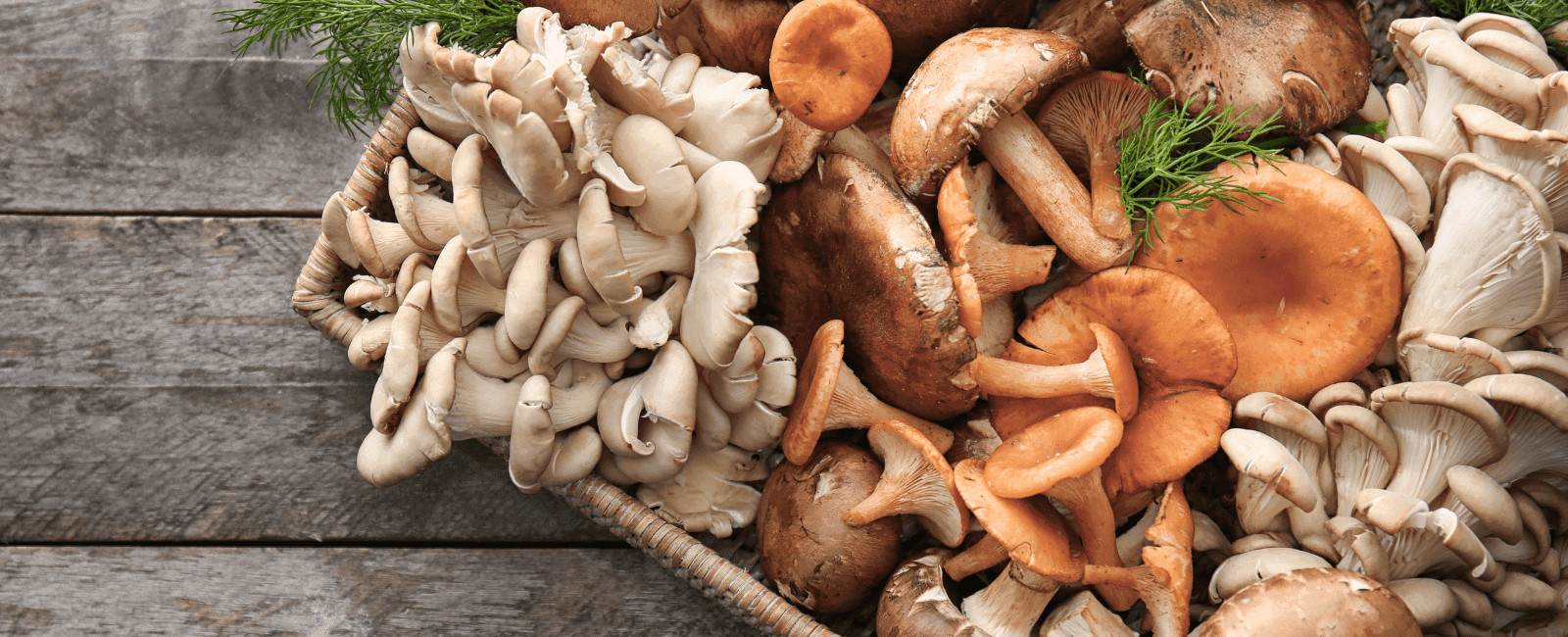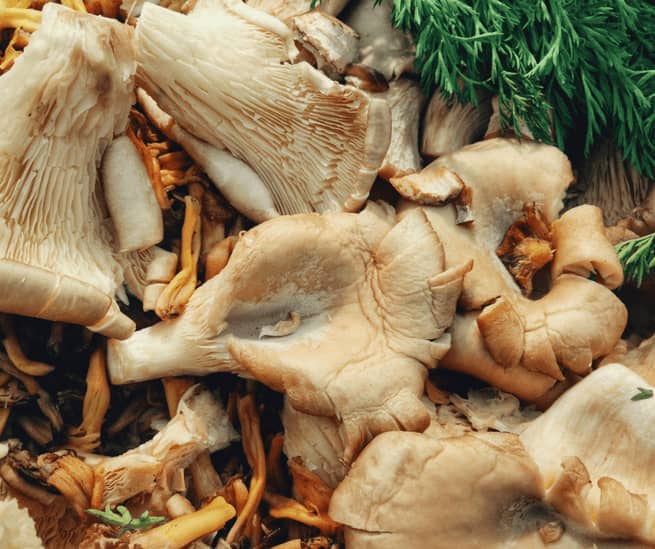

Many cultures had regarded mushrooms as an impactful and important food group long before Western marketing began applying the superfood label. But as these scientific institutions start to dive deeper into research and studies, the list of healthiest mushrooms we can eat continues to grow.
As it does, the data expands, and mushrooms gain acceptance and interest from new audiences. For those looking to add ingredients that provide ample benefits, the world of mushrooms spawns a new realm of possibility.
Weight loss and mushrooms

If you’re searching for foods that can help you attain certain goals, look no further than fungi. Besides bringing a lush, umami flavor to your meals, there are several reasons why mushrooms are suitable for people wanting to manage their weight.
For starters, mushrooms are low in calories, meaning you can eat a larger portion while still trending closer to the calorie deficit needed to reduce weight.
For example, let’s look at the USDA nutritional data for white button mushrooms. One cup of these raw shrooms is estimated to have just 15 calories.
But despite being a low-cal food, edible mushrooms are ripe with dietary fiber, which can help you feel fuller for longer. Foods that are well-endowed with dietary fiber help you avoid overeating or persistent snacking, habits that contribute to gaining or struggling to lose weight.
In many foods, dietary fiber also implies a high volume of carbohydrates, but this isn’t the case for mushrooms. Because of their low-carb composition, healthy mushrooms are an excellent food for managing blood sugar levels.
Finally, most mushrooms are very low in fat, and the fat they do contain is mainly unsaturated. This category is widely regarded as a healthier type of fat (in moderation, of course). Harvard reports that unsaturated fat can “improve blood cholesterol levels, ease inflammation, stabilize heart rhythms, and play a number of other beneficial roles.”
Examination of the relationship between mushrooms and cardiovascular health also points in a positive direction (1).
Incorporating mushrooms into your diet
It couldn’t be easier to begin working this powerhouse of a superfood group into your diet.
The best way to add mushrooms to your plate is in place of high-calorie foods. Meat, grains, or cereal-based products like pasta can all be replaced with mushrooms and will add a change in flavor and texture to your dishes — without the added calories.
And because of their rich umami taste, serving mushrooms instead of meat may help reduce your craving for sodium, which goes a long way toward lowering high blood pressure.
Similarly, mushrooms can be paired with a medley of vegetables and leaner proteins (think: chicken, fish, or tofu) in a stir-fry.
Mushrooms also are natural bedfellows for pillowy, tender greens like baby kale, spinach, or lettuce. Some mushrooms, like cremini, can be eaten raw and make an excellent salad topper when sliced. Other shrooms, like shiitake, should be sautéed before consumption.
Along with salads, sautéed mushrooms are a delectable side dish (especially when studded with garlic and onion). You can season them with rosemary, thyme, and other herbs for Meditteranean flavors — or chili crisp and soy or fish sauce for an Eastern inflection.
Mushroom soup can also be a satisfying, filling, low-calorie meal that’s easy to make in bulk and eat throughout the week. If food prepping is part of your diet plan, a large pot of warming mushroom soup is an excellent place to start.
Immune-supporting health benefits of mushrooms

In addition to having a composition ideal for weight loss regimens, mushrooms offer an exceptionally dense nutrition profile that may benefit your heart health, nervous system, immune functions, blood pressure, and brain health.
All of these benefits can come from a food found at the grocery store! Amazing.
What makes mushrooms so powerful? For starters, they have high concentrations of minerals like selenium, potassium, phosphorus, calcium, and copper.
They are also dense with naturally occurring B vitamins like riboflavin and pantothenic acid, as well as vitamin D — components that help support our overall health.
Additionally, edible fungi are rich in antioxidants, which play a role in decreasing the oxidative stress caused by free radicals (2). Oxidative stress (and its sidekick inflammation) have been linked to the development and spread of cancer cells (3). That being said, antioxidant-rich foods, like mushrooms can exhibit mild forms of anti-cancer and anti-inflammatory properties.
One of mushrooms’ most well-known and valuable antioxidative compounds is the polysaccharide beta-glucan.
Mushrooms and your immune system
In some research, beta-glucans have displayed the ability to activate innate immune cells, which are the immune cells that aren’t typically active (4). Once engaged, these cells can adapt to fight cancer cells and aid in inhibiting the growth of tumors and metastasis – the spread of cancer.
Chaga mushrooms are particularly good at this, which is why they’re commonly used in wellness products.
Other fungi types, such as reishi mushrooms, cordyceps, and turkey tail mushrooms, are especially loaded with beta-glucan; although, because of a bitter taste and tough texture, these varieties are often consumed in mushroom supplements instead of culinary methods.
Scientific findings have suggested that beta-glucans may work as a beneficial adjunctive treatment for breast cancer (5). Additionally, an amino acid called ergothioneine appears to have a preventative effect on prostate cancer (6).
Besides an overt influence on your immune system, mushrooms can also perform undercover functions that support long-term health. A diet rich in edible mushrooms can support a flourishing gut microbiome, which has a rainbow of positive effects for overall health (7).
Along with creating a resilient immune response, some medicinal mushrooms are linked to improving cognitive health, too.
In a study on mice populations, lion’s mane mushrooms showed an ability to reduce biological markers of Alzheimer’s disease (8). Similar research has demonstrated the lion’s mane’s capacity for increasing cognitive health and focus through nerve growth factors synthesizing nerve cells (9).
Healthiest mushrooms to eat
Once again, not all mushrooms are created equally. Plus, some of the most beneficial species have little that makes them attractive in terms of culinary value, which is why mushroom extracts are so popular.
Still, some fungi straddle these two worlds. Here are some of the top shrooms to consume (for your body and taste buds).
1. Maitake mushroom

Because of its native growth, maitake has been a keystone ingredient in Asian cooking for centuries, and for great reason. The mushroom has a unique flavor profile that boasts a bold, earthy flavor with slightly peppery undernotes. Unlike more common culinary mushrooms, maitakes have a texture that is delicate and not squeaky, though it’s best when cooked.
Plus, maitake is considered one of the top mushrooms for medicinal purposes. It can shrink the levels of dangerous types of cholesterol linked to heart disease, and the significant levels of bioactive compounds have robust benefits for immune function, energy levels, and blood glucose levels.
2. Shiitake mushrooms

When you want a shroom with rich, buttery notes that evoke a sense of umami, turn to shiitake mushrooms. They have a slightly meatier texture than maitakes, making them great for grilling and stir-frying. They can be cooked fresh but are also available in a dried form, opening the door to many culinary adventures.
With a miraculous combination of texture and taste, shiitakes can also boost white blood cell production and lower cholesterol thanks to high polysaccharides and amino acid concentrations. Shiitakes are loaded with minerals and are low in fat.
3. Oyster mushroom

There are many edible types of oyster mushrooms – each with varying tastes, colors, and textures. In terms of flavor, most oyster shrooms have a briny seafood essence, though some species, like king trumpets, are not as fishy. You should avoid consuming oyster mushrooms raw. Plus, cooking helps to develop their medium-density texture.
Along with being absolutely delicious, adding oyster mushrooms to your diet is nutritional magic. High levels of vitamin D and magnesium stimulate the body’s calcium processing, while high levels of the amino acid ergothioneine reduce oxidative stress.
4. Lion’s mane

Lion’s mane mushrooms are often a premier component of shroom-based adaptogenic supplements. This shaggy, white fungus has been demonstrated to have remarkable effects on cognitive health and focus, so it’s often seen processed into functional coffee and mushroom tea products. But unlike some of the other medicinal fruiting bodies, lion’s mane has a wide range of culinary uses.
Despite its wooly appearance, the inside of lion’s mane is mild to firm, making it great for sautéeing. This preferred preparation is perfect for the flavor, which expresses itself as a slight saline sweetness — often the reason that lion’s mane mushrooms are used as vegan replacements for scallops, lobster, or other forms of ocean fare.
5. Enoki mushrooms

Edible mushrooms tend to fall into two or three broad categories of flavor: gentle brinish umami or woody earthen umami. Yet enoki straddles the two. They can taste earthy or fishlike — sometimes, they even have faintly fruity notes. Easy to stir-fry or roast, they develop a bouncy, chewy texture when cooked, a particularly great swap for shredded meats.
Along with the diverse cooking applications, enoki has a nutritional profile that makes them extraordinary for wellness diets. They’re high in fiber, low in carbs and fats, and studded with vitamins and minerals. And with solid levels of phenols and polyphenols, enokis are anti-oxidative and anti-inflammatory.
The best mushrooms are whatever ones you’re eating!
It’s apparent – mushrooms have a wide array of benefits, from supporting your body’s resiliency to giving you a category of nutritious and healthy food that fits your weight loss plan. Who said healthy foods couldn’t have flavor?
Just to note – not all mushrooms have the same nutritional profile, and while many of these benefits have been demonstrated, not all are conclusive.
Still, in the end, the best mushrooms are the ones that are available to you. No matter how you consume them, you can still reap a tasty meal that benefits your body from the inside out. Happy eating!
References
1.) Krittanawong, Chayakrit, Ameesh Isath, Joshua Hahn, Zhen Wang, Sonya E. Fogg, Dhrubajyoti Bandyopadhyay, Hani Jneid, Salim S. Virani, and W.H. Wilson Tang. 2021. “Mushroom Consumption and Cardiovascular Health: A Systematic Review.” The American Journal of Medicine 134 (5): 637-642.e2. https://doi.org/10.1016/j.amjmed.2020.10.035.
2.) Pizzino, Gabriele, Natasha Irrera, Mariapaola Cucinotta, Giovanni Pallio, Federica Mannino, Vincenzo Arcoraci, Francesco Squadrito, Domenica Altavilla, and Alessandra Bitto. 2017. “Oxidative Stress: Harms and Benefits for Human Health.” Oxidative Medicine and Cellular Longevity 2017 (8416763): 1–13. https://doi.org/10.1155/2017/8416763.
3.) Reuter, Simone, Subash C. Gupta, Madan M. Chaturvedi, and Bharat B. Aggarwal. 2010. “Oxidative Stress, Inflammation, and Cancer: How Are They Linked?” Free Radical Biology & Medicine 49 (11): 1603–16. https://doi.org/10.1016/j.freeradbiomed.2010.09.006.
4.) D, Akramiene, Kondrotas A, Didziapetriene J, and Kevelaitis E. 2007. “Effects of Beta-Glucans on the Immune System.” Medicina (Kaunas, Lithuania). 2007. https://pubmed.ncbi.nlm.nih.gov/17895634/.
5.) Ostadrahimi, Alireza, Ali Esfahani, Mohammad Asghari Jafarabadi, Jamal Eivazi Ziaei, Aliakbar Movassaghpourakbari, and Nazila Farrin. 2014. “Effect of Beta Glucan on Quality of Life in Women with Breast Cancer Undergoing Chemotherapy: A Randomized Double-Blind Placebo-Controlled Clinical Trial.” Advanced Pharmaceutical Bulletin 4 (Suppl 1): 471–77. https://doi.org/10.5681/apb.2014.070.
6.) Zhang, Shu, Yumi Sugawara, Shiuan Chen, Robert B. Beelman, Tsuyoshi Tsuduki, Yasutake Tomata, Sanae Matsuyama, and Ichiro Tsuji. 2019. “Mushroom Consumption and Incident Risk of Prostate Cancer in Japan: A Pooled Analysis of the Miyagi Cohort Study and the Ohsaki Cohort Study.” International Journal of Cancer, September. https://doi.org/10.1002/ijc.32591.
7.) Jayachandran, Muthukumaran, Jianbo Xiao, and Baojun Xu. 2017. “A Critical Review on Health Promoting Benefits of Edible Mushrooms through Gut Microbiota.” International Journal of Molecular Sciences 18 (9): 1934. https://doi.org/10.3390/ijms18091934.
8.) Tsai-Teng, Tzeng, Chen Chin-Chu, Lee Li-Ya, Chen Wan-Ping, Lu Chung-Kuang, Shen Chien-Chang, Huang F. Chi-Ying, Chen Chien-Chih, and Young-Ji Shiao. 2016. “Erinacine A-Enriched Hericium Erinaceus Mycelium Ameliorates Alzheimer’s Disease-Related Pathologies in APPswe/PS1dE9 Transgenic Mice.” Journal of Biomedical Science 23 (1). https://doi.org/10.1186/s12929-016-0266-z.
9.) Saitsu, Yuusuke, Akemi Nishide, Kenji Kikushima, Kuniyoshi SHhimuzu, and Koichiro Ohnuki. 2019. “Improvement of Cognitive Functions by Oral Intake of Hericium Erinaceus.” Biomedical Research 40 (4): 125–31. https://doi.org/10.2220/biomedres.40.125.
10.) Lai, Puei-Lene, Murali Naidu, Vikineswary Sabaratnam, Kah-Hui Wong, Rosie Pamela David, Umah Rani Kuppusamy, Noorlidah Abdullah, and Sri Nurestri A. Malek. 2013. “Neurotrophic Properties of the Lion’s Mane Medicinal Mushroom, Hericium Erinaceus (Higher Basidiomycetes) from Malaysia.” International Journal of Medicinal Mushrooms 15 (6): 539–54. https://doi.org/10.1615/intjmedmushr.v15.i6.30.


